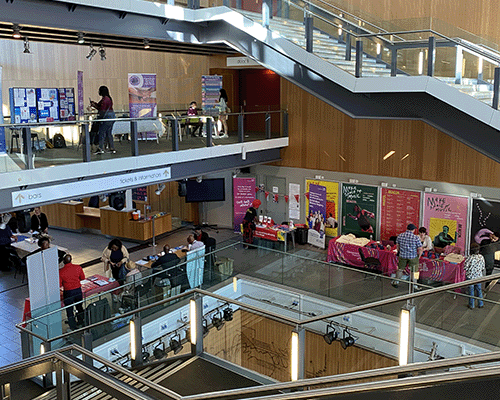Engaging with communities: A pathway to shared decision making
By Dr Marie Nugent on
Marie has a PhD in Genetics and went straight into science communication and engagement in industry. Marie is Community Manager within the Diverse Data team, where she will be developing connections and building networks between patients, clinicians, researchers and institutions. Marie gives her take on how our Diverse Data Initiative needs to engage with communities.
Why engagement matters within the Diverse Data initiative
The Diverse Data initiative aims to address inequalities in genomic data, which in turn might exacerbate inequalities in health. There is evidence to suggest that many previous attempts to address inequalities have led to unintended consequences that have ultimately had little to no effect on equality of health outcomes, and on occasions has risked further adding to inequities. An example of this is the Human Genome Diversity Project (HGDP) that aimed to explore global human genetic diversity. It has been said the project overlooked the potential social, financial, and cultural harms to Indigenous groups. This had lasting implications for trust in researchers, and the HGDP was criticised for resembling activities of European colonialists (Roberts, 2011; Dodson and Williamson 1999; Greely 2001; TallBear 2007; Claw et al. 2018).
It is therefore fundamental to the success of this initiative to:
- mitigate wherever possible known negative consequences of diversity-driven interventions,
- from the start, embed models of practice already recommended and backed by evidence,
- to allow a greater variety of voices in shaping this work and its outcomes, most pertinently, those who are being targeted for such interventions.
We are at the forefront of discovery, funded through the Department of Health and Social Care, and as such, we have a responsibility to be transparent and open with our decision making regarding our intentions, our priorities, our resources, how they are applied and shared, and how our work is interpreted and presented. We therefore need to be ambitious with pushing the status quo regarding traditional models of decision making, governance, ethics and engagement in biomedical and health research and engagement. The aspiration with this is that it will create high quality research and future-proof our work so it will remain relevant and useful for future initiatives and the wider sector.
Governance and engagement
Governance describes a process whereby decisions are made by a select group of people deemed custodians of the work and its impact. We know from research that people within under-served communities are rarely in a position of power to govern the work through which they are being targeted, creating opportunity for misunderstanding, misinterpretation and exacerbating mistrust.
Engagement, on the other hand, is a huge umbrella term that covers a wide range of interactions, activities, groups and intentions. Engagement often includes activities such as insight generation for designing communications materials, and research participant recruitment. These activities, however, do not often provide space for participants to shape the work itself and its intentions.
For me, the word ‘engagement’ describes the spectrum of activities we need to do to foster relationships and understanding across our diverse range of stakeholders, with the intention of working towards shared decision making and integration with our partners. For me, the purpose of engagement is to build trust and understanding, which is best demonstrated through actively listening and adapting work to better suit the needs of the people.
It may not be useful to adopt existing models exactly - we may need to experiment to find the right fit for what we aim to deliver. We should be taking opportunities to test new ways of collective working across our wide variety of stakeholders. Thankfully, organisations such as the James Lind Alliance have methods for setting up priority-setting partnerships and exercises to ‘enable clinicians, patients and carers to work together to identify and prioritise evidence uncertainties in particular areas of health and care that could be answered by research’. We can take inspiration from this approach as a good starting point for putting our intentions into practice. These methods demonstrate the impact that sustained engagement can have on community building and supporting shared decision making. However, the process can take years to complete, often requires dedicated resource, and funding constraints can make this commitment for co-creation tricky post funding.
For me, as an important founding principle, our engagement activity needs to provide the stepping stones to building shared decision-making capacity for our initiative from a diverse range of partners. In my view, this is most importantly relevant to people who are otherwise left out of decision-making power, yet are the target groups for participation.
I have previously taken advantage of working in the grey areas within my institutional context, by which I mean leaning into the kind of projects that do not neatly fit within X remit of Y department and require a collaborative, innovative approach. I would draw on whatever I felt could create the biggest shift in attitudes around the role of engagement in research and/or institutional context. I have had the privilege of working with a fantastic array of people on a range of projects over the years and through them I have learnt so much. The wisdom I can glean from this variety is that approach is everything. The ‘why’, then the ‘how’, then the ‘what’. Involving diverse people in the ‘why’ and ‘how’ will inevitably make the ‘what’ better. Within the research sector context, CEO (Chief Executive Officer) of UKRI (UK Research Institute) Prof Dame Ottoline Leyser has defined excellence as diversity in its broadest sense, recognising there is a wide ecosystem through which research happens and benefits society, and the role of the institution is the good steward of that ecosystem. Sadly, the reality is that many of our institutional policies and practices are often too rigid to allow effective engagement and involvement of communities in research design, and one can hit barriers to truly equitable working practice and outcomes as a result.
Lessons from the field
To share a specific example, in December 2019 I led a team of people consisting of community members with experience in advocating for health awareness in their community settings, recruited a project officer with a keen interest in decolonising STEM (Science, Technology, Engineering and Mathematics). There was a Professor in Sociology, an NHS-based PPIE (Patient and Participant Involvement and Engagement) & Governance lead, and a local community organiser from Citizens UK. We were creating a project focused on exploring approaches to place-based (or postcode-based) engagement with research within perceived disadvantaged communities. We named the project Leicester Voices and made all the materials we created as part of that work accessible on Figshare.
The ‘why’ of this work had been relatively pre-determined through the funder to explore models of community-led practise for engagement, recognising that institutions do not go far enough to actively involve disadvantaged communities in shaping research and engagement. I knew that, for me, the most important thing was to ensure we built the trust of the community members we were working with. I felt strongly that the best way to demonstrate that was to genuinely flex the ways in which we supported each of our community members to do the listening work in their settings and place trust in them to decide how to the best share back those findings with the institutional partners. They were the experts in engaging their communities effectively and we wholeheartedly respected that.
Within a couple of months of starting this work, you guessed it, COVID struck! This changed all our plans and, more importantly, people’s lives were thrown up in the air. The communities we were wanting to engage in the work were precisely those who were hit hardest by the pandemic. We had no idea if or how we could continue our work together, and I made no assumptions. We primarily used our time to check in on each other, make sure we were okay and understand how people were being impacted. We decided, together, that we could continue our work, we were all still keen to, and that we just needed to think differently about the ‘how’.
As a result, we were not only able to create an insightful list of 10 health priorities from communities, by communities. We were all involved in reviewing the ways in which our work was captured, presented, and shared with others. We experienced friction around how to talk about ethnic minority communities and about associated risk of disease from health research, with differing views on whether it was right to speak to this being based on ethnicity or inequality. We were able to reflect on the role of agility and trust in effectively delivering community-led work. We published a paper highlighting that it is not the ‘hard to reach’ communities that made this work difficult but instead the lack of management capacity within institutions – it was the rigid, inequitable practices, and policies within them that actively work against achieving trust and cocreation. We created a strong team and developed real relationships as a result of working together in this way. We all learnt so much from this and I know my wonderful colleagues agree with me that is has impacted how I think about community-led, trust-building work forever.
The Diverse Data initiative and engagement
Within the Diverse Data initiative, we have an opportunity to create a powerful cocreated set of research priorities set by patients, community advocates, a wide range of specialists and colleagues to further explore the opportunity for genomics to push forward research and improved outcomes for patients of Sickle Cell Disease and for women’s reproductive health. We can then use this set of priorities to rally researchers and organisations to respond, whilst facilitating patient and public involvement to ensure participants are given the support needed to be more actively involved in shaping research that targets and impacts them and their communities.
It is my intention to carefully manage this process. I aim to make sure that we can continue to build trusted, equitable relationships across all the people involved, no matter their background. The process should support people to sustain their engagement over the course of our programme. This will ensure we stay true to what our communities want to see and how they want us to do it.
Watch this space.


